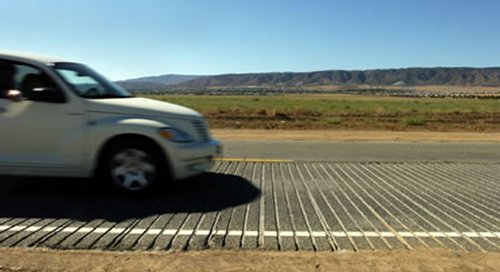Musical Pathways and Roads

Musical Roads, as the name suggests, are roads that can “play” a song while you are driving on them. The first report of a musical road was in 1995 in Denmark. The Asphaltophone was an artistic installation piece that used raised (mini-speed) bumps in the road to play a song.
In 2007, a Japanese construction worker noted that he could hear an almost musical sound after scraping up a part of the road with his bulldozer and then driving over the scraps. Since 2007, Japan has created three “melody roads” which were designed to attract tourists and keep drivers from speeding. They were designed to be heard optimally at exactly the speed limit. Unlike the Danish road, these roads had grooves cut into the asphalt at precise distances from each other and of appropriate depths. The distance spacing defined the pitch and the depth defined the sound level.
South Korea followed suit and created a “singing road” using the same groovy technology. However, the intent in South Korea was for safety. Statistics show that about 68% of traffic accidents occur because of driver inattentiveness or falling asleep at the wheel. At the proper speed, the song was Mary had a Little Lamb.
And in 2008, Lancaster, California, built its first musical road. Lancaster is about a one-hour drive north of downtown LA. The town selected the finale from the William Tell Overture, best known as the theme music from the old Lone Ranger radio and TV program. That was an unfortunate song choice since the faster you drive, the better it sounds. At least it’s not as bad as the Brahms Lullaby which would put drivers to sleep. Initially there were complaints from local residents, so the portion of the road that was musical was moved away from residential areas. This road is named after the Honda Civic and was used in a Honda commercial. Here is a YouTube video of someone driving on the road. Personally I could not identify it as the William Tell Overture I suspect that the road engineers made some calculation errors.
It is interesting to think about what songs and melodies would be a good choice for the highway. Some melodies may sound odd if played off tempo; others, like the William Tell Overture, might be the subject of a legal battle if someone, ticketed for speeding, complained that he was entrapped into going too fast by the local municipality and that the musical road was a trick to encourage people to speed to fill the city coffers.
Calculating the exact distances necessary for any particular tune is also interesting. Since it only involves multiplication and division, even a junior high school student should be able to do the calculations, and indeed next time, I will draft the local junior high school students for their assistance. For the process, click on a blog I wrote for HearingHealthMatters.org about a decade ago at Musical roads, part 2 | Marshall Chasin | HearingHealthMatters.org/HearTheMusic .
Over the years I have been involved with several music roads in Turkey, Columbia, and most recently, the PAULANER SoundTrack at the Munich Airport in Germany… just in time for Oktoberfest. I was contacted by the Thjnk Group in Germany and their idea was to have a musical pathway created with well-spaced grooves such that, as arriving passengers rolled their suitcases behind them, the suitcase wheels would play the famous beer-drinking song Ein Prosit. Of course, travelling 60 mph (or 100 km/hour) is different than walking speed, but all one needs to do is divide by 20 (ish). I walk at 5 km/hour or around 3 mph. The spacings would need to be 20 times closer than for highway speeds.
From the folks at Thjnk “From the approximately six million guests who visit the world’s largest folk festival every year, around 20% of them travel from abroad. In order to become the favorite beer brand of international Oktoberfest visitors, Paulaner, in collaboration with the creative agency Thjnk, kicked off Octoberfest 2023 in a very special way – with the Paulaner SoundTrack. The Paulaner SoundTrack is a walkable path made of acrylic glass into which precise grooves have been carved. If a person walks along this path with his rolling suitcase at the speed set by a beam of light, the famous melody of “Ein Prosit der Gemütlichkeit” can be heard. The song is an Oktoberfest classic; it stands like no other for the love of beer – and it is played everywhere. So, after a long journey, this melody gets visitors straight into the Oktoberfest mood. Everyone was able to experience the publicly accessible installation at Munich Airport during Oktoberfest season. All experiences were shared under #celebratetheprost”
A video of the SoundPathway at Munich Airport can be found at https://youtu.be/nGgMl6S8h3U?si=fRtBfubCduusIzmK

